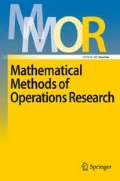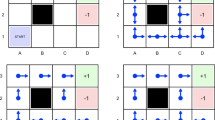Abstract
In this article we consider how the operator of an electric power system should activate bids on the regulating power market in order to minimize the expected operation cost. Important characteristics of the problem are reaction times of actors on the regulating market and ramp-rates for production changes in power plants. Neglecting these will in general lead to major underestimation of the operation cost. Including reaction times and ramp-rates leads to an impulse control problem with delayed reaction. Two numerical schemes to solve this problem are proposed. The first scheme is based on the least-squares Monte Carlo method developed by Longstaff and Schwartz (Rev Financ Stud 14:113–148, 2001). The second scheme which turns out to be more efficient when solving problems with delays, is based on the regression Monte Carlo method developed by Tsitsiklis and van Roy (IEEE Trans Autom Control 44(10):1840–1851, 1999) and (IEEE Trans Neural Netw 12(4):694–703, 2001). The main contribution of the article is the idea of using stochastic control to find an optimal strategy for power system operation and the numerical solution schemes proposed to solve impulse control problems with delayed reaction.









Similar content being viewed by others
Notes
The term secondary control is reserved for a second automatic frequency control system, that is used in some power systems. In some markets, particularly in Northern America, what we here refer to as tertiary control is termed following reserve (Ela et al. 2011).
References
Andersen L, Broadie M (2004) Primal-dual simulation algorithm for pricing multidimensional American options. Manag Sci 50(9):1222–1234
Balansansvarsavtal 2011 (Swedish). Technical report, Svenska Kraftnät, 2010
Bar-Ilan A, Sulem A, Zanello A (2002) Time-to-build and capacity choice. J Econ Dyn Control 26(1):69–98
Bergen AR, Vittal V (2000) Power systems analysis. Prentice-Hall, New Jersey
Bibby BM, Sørensen M (1995) Martingale estimation functions for discretely observed diffusion processes. Bernoulli 1(1–2):17–39
Carmona R, Ludkovski M (2008) Pricing asset scheduling flexibility using optimal switching. Appl Math Financ 15:405–447
Chassagneux JF, Elie R, Kharroubi I (2010) Discrete-time approximation of multidimensional BSDEs with oblique reflections. Preprint
DeMarco C, Bergen AR (1987) A security measure for random load disturbances in nonlinear power system models. IEEE Trans Circuits Syst 34(12):1546–1557
Deng SJ, Xia Z (2006) A real options approach for pricing electricity tolling agreements. Int J Inf Technol Decis Mak 5(3):421–436
Dixit AK, Pindyck RS (1994) Investment under uncertainty. Princeton University Press, Princeton
Djehiche B, Hamadéne S (2009) On a finite horizon starting and stopping problem with risk of abandonment. Int J Theor Appl Financ 12:523–543
Djehiche B, Hamadéne S, Popier A (2009) A finite horizon optimal multiple switching problem. SIAM J Control Optim 47(4):2751–2770
El Asri B, Hamadéne S (2009) The finite horizon optimal multi-modes switching problem: the viscosity solution approach. Appl Math Optim 60:213–235
Ela E, Milligan M, Kirby B (2011) Operating reserves and variable generation. Technical Report NREL/TP-5500-51978, National Renewable Energy Laboratory (NREL)
El-Karoui N, Kapoudjian C, Pardoux E, Peng S, Quenez MC (1997) Reflected solutions of backward SDEs, and related obstacle problems for PDEs. Ann Probab 25(2):702–737
Gobet E, Lemor JP, Warin X (2005) A regression-based Monte-Carlo method to solve backward stochastic differential equations. Ann Appl Probab 15:2172–2202
Hamadéne S, Jeanblanc M (2007) On the starting and stopping problem: application in reversible investments. Math Oper Res 32:18–192
IEEE/CIGRE Joint Task Force on Stability Terms and, Definitions (2004) Definition and classification of power system stability. IEEE Trans Power Syst 19(3):1387–1401
Longstaff FA, Schwartz ES (2001) Valuing American options by simulation: a simple least-squares approach. Rev Financ Stud 14:113–148
Nowicka-Zagrajek J, Weron R (2002) Modeling electricity loads in California: ARMA models with hyperbolic noise. Signal Process 82:1903–1915
Nwankpa CO, Shahidehpour SM, Schuss Z (1992) A stochastic approach to small disturbance stability analysis. Trans Power Syst 7:1519–1528
Øksendal B, Sulem A (2008) Optimal stochastic impulse control with delayed reaction. Appl Math Optim 58:243–255
Olsson M, Perninge M, Söder L (2010) Simulation of real-time balancing power demands in power systems with wind power. Electr Power Syst Res 80:966–974
Perninge M (2011) A Stochastic control approach to include transfer limits in power system operation. PhD thesis, KTH
Perninge M, Knazkins V, Amelin M, Söder L (2011) Modeling the electric power consumption in a multi-area system. Eur Trans Electr Power 21(1):413–423
Perninge M, Söder L (2012) Optimal activation of regulating bids to handle bottlenecks in power system operation. Electr Power Syst Res 83:151–159
Porchet A, Touzi N, Warin X (2009) Valuation of power plants by utility indifference and numerical computation. Math Methods Oper Res 70:47–75
Tsitsiklis JN, Van Roy B (1999) Optimal stopping of Markov processes: Hilbert space theory, approximation algorithms, and an application to pricing high-dimensional financial derivatives. IEEE Trans Autom Control 44(10):1840–1851
Tsitsiklis JN, Van Roy B (2001) Regression methods for pricing complex American-style options. IEEE TransNeural Netw 12(4):694–703
Weron R (2006) Modeling and forecasting electricity loads and prices: a statistical approach. Wiley, London
Wood AJ, Wollenberg BF (1996) Power generation, operation, and control, 2nd edn. Wiley, New York
Author information
Authors and Affiliations
Corresponding author
Additional information
M. Perninge is a member of the LCCC Linnaeus Center and the eLLIIT Excellence Center at Lund University.
Rights and permissions
About this article
Cite this article
Perninge, M., Söder, L. Irreversible investments with delayed reaction: an application to generation re-dispatch in power system operation. Math Meth Oper Res 79, 195–224 (2014). https://doi.org/10.1007/s00186-013-0459-0
Received:
Accepted:
Published:
Issue Date:
DOI: https://doi.org/10.1007/s00186-013-0459-0




